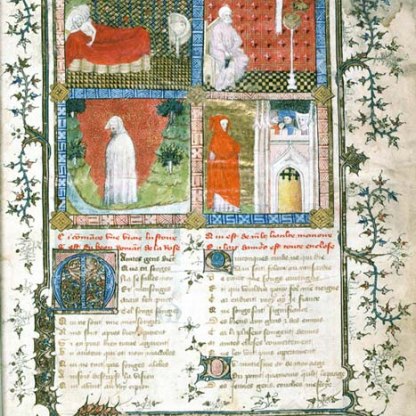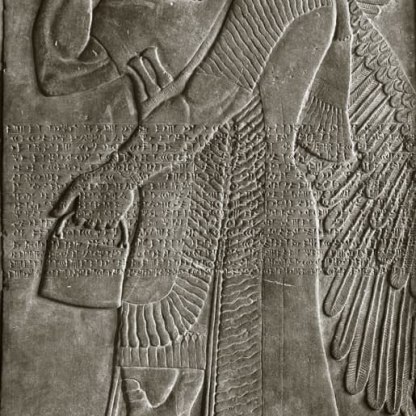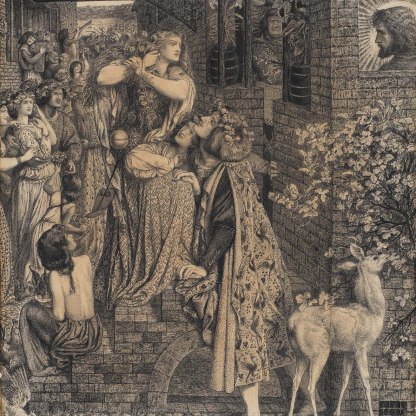The Kelmscott Chaucer

Chaucer is very much the same sort of person as Morris ... the value of their work comes from the extreme simplicity and beautiful directness of their natures.
Edward Burne-Jones, quoted by his wife Georgiana in Memorials of Edward Burne-Jones, vol. 2, 1904
The artist Edward Burne-Jones met the designer, writer and political activist William Morris when both were undergraduates at Oxford in the early 1850s. The two remained close friends and collaborators until Morris's death. Yet from the very beginning, there was a third party to this friendship, an Englishman who had died more than four hundred years before either of their births: Geoffrey Chaucer, the poet to whom Morris referred as 'my master'.
In the memoir of her husband quoted above, Georgiana Burne-Jones records how he and Morris would read Chaucer's work together in their college rooms and then visit the Bodleian, Oxford's University library, to study old manuscripts. These twin interests – medieval books and poetry – would, fifty years later, come together and materialise in the form of the Kelmscott Chaucer, a volume widely considered to be the most beautiful book ever printed.
Morris turned to book-printing relatively late in his career, although he had been producing manuscripts and practising calligraphy since the 1860s. On the left is a page from his own manuscript of a thirteenth-century Icelandic saga, The Story of Hen Thorir, in the Fitzwilliam Library [MS.270.f.1r].
Inspired by the printer Emery Walker, Morris set up the Kelmscott Press in Hammersmith, London, in January 1891. It was named after Kelmscott Manor, the Tudor farmhouse on the Thames near Oxford where he spent his summers. Between 1891 and 1898, fifty-three titles were printed, with all the typefaces and subsidiary decoration designed by Morris. The Fitzwilliam has a complete collection of these editions.
Morris's secretary at the Press was Sydney Cockerell, left, who went on to become the Director of the Fitzwilliam Museum between 1908 and 1937. In 1898, two years after Morris's death, Cockerell oversaw the publication of the Press' final book, A Note by William Morris on his Aims in Founding the Kelmscott Press, in which the founder is quoted as follows:
I began printing books with the hope of producing some which would have a definite claim to beauty, while at the same time they should be easy to read and should not dazzle the eye, or trouble the intellect of the reader by eccentricity of form in letters.
Morris demanded that every element of the book have a unity of design: the binding, the paper, the ink, the typeface and the illustrations should all complement one another and contribute to the overall decorative effect. Morris conceived each double spread as a single design.
The opening two pages, illustrated in the margin here, show well the decorative qualities of the Kelmscott Chaucer. The title of the book is enclosed in a white border, the letters surrounded by elaborately curling foliage. A border of vine scrolls contains a panel on each page, a pattern that is repeated throughout. This, and several of the initial letters, were reproduced with the help of photographic methods, a concession to modern production techniques that Morris accepted with some reluctance.
Beneath the illustration – which is itself surrounded by a further floral border – the text is divided into two regular columns, and headed by a box containing the elaborately lettered word 'When'.
Perhaps the most striking decorative elements in the book are the eighty-seven woodcut illustrations based on Burne-Jones's drawings. The Fitzwilliam owns several of the artist's preliminary sketches and finished designs for these.
Left [1050-37] is one of the completed drawings for Chaucer's version of The Romance of the Rose, a popular allegorical tale from the middle ages. Right [1050-28], we see Chaucer himself in his study, kneeling before a vision of the Virgin and Child.
A leaf from Burne-Jones' sketch book can be seen left [1079.XXIV.p.563]. The poet is once more in his study, seated at his desk this time, writing intently and apparently oblivious to the muse-like figures who stream through his door.
After four years' work by Morris, Burne-Jones and their engraver William Hooper, the book was completed. The first editions were finished only a few months before Morris's death in 1896. 425 copies of the Kelmscott Chaucer were eventually printed and sold for £20 each. The example in the Fitzwilliam is one of fourty-six special editions bound in pigskin, left [21.M.1].
Themes and periods
Data from our collections database
Colophon: " ... edited by F. S. Ellis; ornamented with pictures designed by Sir Edward Burne-Jones and engraved on wood by W. H. Hooper. Printed by me William Morris at the Kelmscott Press ... finished on the 8th day of May 1896 ..." One of 425 copies. Binding: One of 48 bound at the Doves Bindery in full white pigskin, monogrammed and dated, 1902. Manuscript inscription on front end pages: 'to Jenny With WM's best love June 6th 1896'.
Ii, [2], 554 pages, 44cm
Acquisition and important dates
- Method of acquisition: Bequeathed
- Dates: 1935
Dating
Maker(s)
- Chaucer, Geoffrey Author
- Ellis, F. S. Editor
- Burne-Jones, Edward Illustrator
- Hooper, W. H. Engraver
- Morris, William Printer
- Kelmscott Press
- Doves Bindery Binder
Other highlight objects you might like
Suggested Curating Cambridge products
Sign up to our emails
Be the first to hear about our news, exhibitions, events and more…





